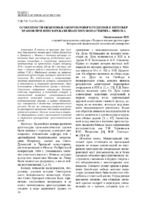| dc.contributor.author | Ожешковская, И. Н. | ru |
| dc.coverage.spatial | Минск | ru |
| dc.date.accessioned | 2018-06-26T10:02:16Z | |
| dc.date.available | 2018-06-26T10:02:16Z | |
| dc.date.issued | 2018 | |
| dc.identifier.citation | Ожешковская, И. Н. Особенности объемно-планировочного решения и интерьер храмов при женских базилианских монастырях г. Минска = Features of the architecture of Minsk female basilian monasteries / И. Н. Ожешковская // Архитектура : сборник научных трудов. – 2018. – Вып. 11. – С. 34-39. | ru |
| dc.identifier.uri | https://rep.bntu.by/handle/data/42706 | |
| dc.description.abstract | В статье на примерах двух женских базилианских монастырей Свято-Духовского и Троицкого г. Минска с помощью архивных источников были рассмотрены особенности организации планировки и устройства сакрального пространства на протяжении первой половины XVII - первой половины XIX вв. Все они были связаны с уставом ордена и решениями Замойского собора 1720 г. Наибольшее влияние на развитие униатской архитектуры оказывало католическое зодчество. Все эстетические и эмоциональные средства воздействия на человека, сложившиеся в католицизме в сакральной архитектуре, были использованы в базилианских храмах и каплицах. Стремление подражать интерьерам богатых костелов отразилось в композиции алтарей, в католической символике, иллюзионистической живописи, стукковой пластике, декоративно-художественных приемах, в выборе строительных материалов и богатстве колористического решения. Но все же интерьер униатского храма не растворился полностью под знаком западноевропейского влияния. Наличие иконостаса позволило сформировать синтез христианских традиций в сакральном пространстве греко-католической церкви. | ru |
| dc.language.iso | ru | ru |
| dc.publisher | БНТУ | ru |
| dc.title | Особенности объемно-планировочного решения и интерьер храмов при женских базилианских монастырях г. Минска | ru |
| dc.title.alternative | Features of the architecture of Minsk female basilian monasteries | en |
| dc.type | Article | ru |
| local.description.annotation | In the article on the basis of archival sources there were discussed the peculiarities of the organization of planning and establishing of sacred space on the examples of two female Basilian monasteries of the Holy spirit and Troitsky monasteries in Minsk during the first half of the 17th century and the first half of the 19th century. All of them were associated with the statute of the Order and the decisions of the Council of Zamoyskiy in 1720. The greatest influence on the development of Uniate architecture was provided by Catholic architecture. All aesthetic and emotional means of influence on a person, formed in Catholicism in sacral architecture were used in the Basilian temples and chapels. The desire to imitate the interiors of rich churches was reflected in the composition of altars, in Catholic symbolism, illusionistic painting, stuсco plastic, decorative and artistic techniques, in the choice of building materials and the richness of the color decision. But still the interior of the Uniate Church did not completely disappear under the sign of Western European influence. The presence of the iconostasis made it possible to form a synthesis of Christian traditions in the sacred space of the Greek Catholic Church. | en |

